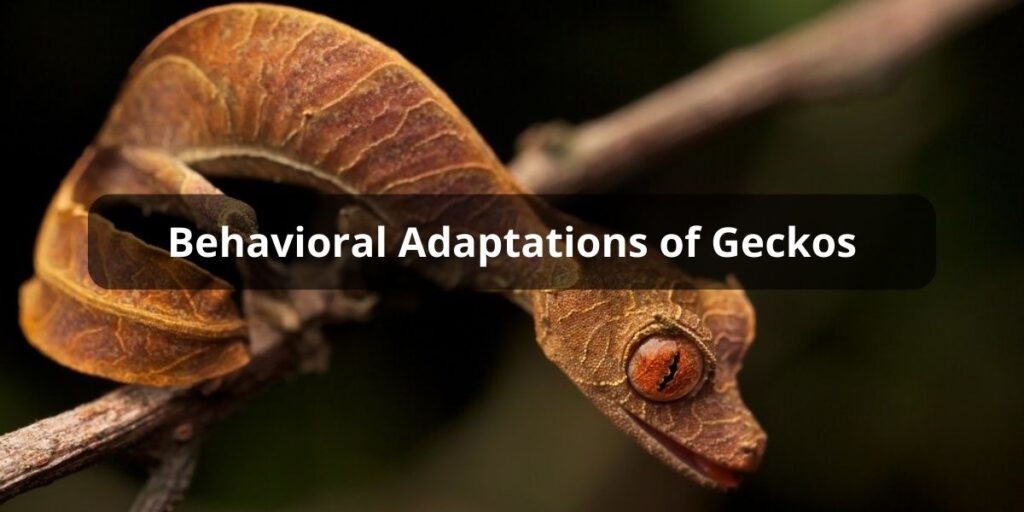Geckos are a unique group of lizards found in warm climates worldwide. They possess several interesting behavioral adaptations that aid their survival in various environments. In this article, we will explore some of the key behavioral adaptations of geckos.
Geckos come in a wide variety of shapes, sizes, and colors. There are over 1500 described species of geckos found on every continent except Antarctica. Geckos inhabit diverse environments including deserts, rainforests, grasslands, caves, and even urban areas. Their ability to thrive in these varying habitats depends on the behavioral adaptations they have evolved over millions of years.
Geckos are most famous for their specialized toe pads that allow them to climb vertical surfaces and even walk upside down on ceilings. But they have also developed many other clever behaviors that help them evade predators, regulate body temperature, locate food, and communicate. Understanding how and why geckos behave in certain ways provides fascinating insight into their biology and ecology.
Gecko Behavioral Adaptations
Camouflage and Crypsis

One of the gecko’s key defenses against predation is camouflage and crypsis. Their skin colors and patterns act as camouflage, allowing geckos to blend into their surroundings undetected. Species like leaf-tailed geckos have elaborate body shapes and skin flaps that resemble leaves and bark, disguising them as part of the vegetation. Other geckos have disruptive patterns that break up their body outline. These adaptations make it difficult for predators to spot geckos against complex visual backgrounds. When threatened, geckos will also remain perfectly still to avoid detection through movement. This cryptic behavior allows them to essentially hide in plain sight.
Tail Autotomy
Many geckos have the ability to shed their tails through a process called caudal autotomy. When grabbed by a predator, geckos can detach their tails as a self-defense mechanism. The wriggling tail distracts the predator while the gecko makes its escape. Although losing its tail impairs the gecko’s fat storage and balance, the tail will regrow over time. Tail autotomy is an effective adaptation that allows geckos to avoid being killed and eaten. Interestingly, some species have enhanced this adaptation by having brightly colored tail tips that draw even more attention when shed.
Thermoregulation
As ectotherms, geckos rely on external heat sources to regulate their body temperature. To maintain optimal temperatures, geckos exhibit thermoregulatory behaviors. When too hot, they seek out cooler microhabitats like shades and burrows. If too cold, geckos bask in sunlight on rocks or tree trunks. Species like the moorish gecko flatten their bodies to maximize heat absorption. Geckos may also alter their posture to expose more or less surface area relative to environmental temperatures. These thermoregulatory movements allow geckos to maintain ideal body temperatures for digestion, immune function, and energy levels.
Locomotion and Agility
Geckos are remarkably agile reptiles capable of rapid acceleration, jumping, clinging, and climbing. Their specialized toe pads, prehensile tails, and grasping limbs give them impressive mobility on a variety of terrain. Terrestrial geckos can run extremely fast with lateral undulations of their bodies. Arboreal species use their prehensile tails for balance while climbing trees and vines. Large-eyed geckos have evolved expanded fields of vision that aid their navigation through dense foliage. Many geckos can also vocalize distress calls when threatened to warn others or temporarily stun predators. Overall, geckos possess diverse locomotive abilities vital for foraging, escaping danger, and avoiding obstacles in complex environments.
Social Interactions
While most geckos are solitary and territorial, some species exhibit fascinating social behaviors. The mourning gecko is one of the few geckos known to live communally in large groups. They tolerate other individuals and cooperate to defend shared territories. Other geckos may form male-female pair bonds during breeding season. Social interactions are mediated through chemical and visual signaling – geckos have eyelids that allow them to “blink” and convey visual messages. Tactile cues like rubbing heads or biting also play a role in social dynamics. Understanding gecko social behavior provides insight into the evolution of lizard communication and cooperation.
Conclusion
In summary, geckos have evolved a diverse array of behavioral adaptations for survival and reproduction. Their cryptic coloration, tail autotomy, thermoregulation, agility, and social interactions allow geckos to thrive in habitats worldwide. Studying gecko behavior continues to reveal fascinating aspects of lizard biology. Furthermore, many gecko adaptations have inspired bio-inspired technologies, like adhesives modeled after their unique toe pads. As we learn more, geckos will remain an intriguing example of how evolution shapes animal behaviors. Their flexible and specialized behaviors enable geckos to exploit diverse ecological niches, underscoring their amazing resilience and adaptability.
FAQs
What are the social and territorial behavior adaptations of geckos, especially during mating seasons?
During mating seasons, geckos often display territorial behavior to establish and defend their breeding territories. This can involve head bobbing, tail wagging, or vocalizations to signal dominance and attract mates. Some species are solitary, while others form temporary social groups for mating.
Do geckos exhibit temperature-dependent behaviors and adaptations for thermoregulation?
Yes, geckos exhibit temperature-dependent behaviors to regulate their body temperature. They bask in sunlight or under heat sources to raise their temperature and become more active. Conversely, they seek shade or cooler areas when they need to cool down. This thermoregulation is essential for their metabolic processes.
How do geckos use vocalizations or other forms of communication as behavioral adaptations?
Geckos use various vocalizations such as chirping, clicking, or hissing for communication. These sounds serve purposes like territorial disputes, mating calls, or warning signals. Additionally, they may use body language and visual cues like head movements for communication with conspecifics.
What are the predator avoidance and defense strategies employed by geckos as behavioral adaptations?
Geckos employ several predator avoidance and defense strategies. They often rely on camouflage to blend into their surroundings, making them less visible to predators. When threatened, they may employ tail autotomy, shedding their tail as a distraction, and use fast, erratic movements to escape. Some geckos may also vocalize or hiss to deter predators.
Are there variations in behavioral adaptations among different gecko species?
Yes, there are significant variations in behavioral adaptations among different gecko species. These adaptations are often influenced by their specific habitats, dietary preferences, and predator pressures. For example, arboreal geckos may have different climbing and hiding behaviors compared to terrestrial species, and the mating behaviors can vary widely among species.



